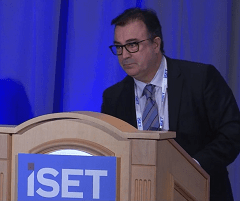
A multicentre experience with the 4 French (4Fr) WavelinQ endoAVF system (BD) has found that the device is safe and effective, bolstering existing evidence that it could offer an alternative option to surgically created arteriovenous fistulas (AVFs) in the dialysis access algorithm. The study, and this viewpoint, were presented by Bulent Arslan (Rush University Medical Center, Chicago, USA) at this year’s International Symposium on Endovascular Therapy (ISET 2022; 16–19 January, Hollywood, USA).
The speaker began by noting that he was not directly involved in the presented study—which has been published by Todd Berland (New York University, New York, USA) and colleagues, on behalf of the WavelinQ 4 French investigators, in the Journal of Vascular Surgery (JVS). Arslan outlined key differences between the second generation 4Fr WavelinQ system and the older 6Fr system, detailing that the former enables radial-to-radial AVF creation, in addition to the ulnar-to-ulnar option, and also has a smaller profile.
Discussing the JVS study, he stated that it aggregated findings from three different, prospective studies (EASE, EASE-2 and EU/CA) conducted at a total of 14 centres across Canada, Europe and South America. The sum patient population in the three studies was 120 (97 males [80.8%], mean age=54.6), he added, with the objective being to analyse safety and performance data in patients treated with the 4Fr WavelinQ system.
Procedural success was achieved in 116 patients (96.7%), Arslan continued, and the investigators reported a mean procedure time—from initial puncture to applying dressing—of 84 minutes. Regarding location, a little over three quarters of the fistulas were ulnar-ulnar anastomoses. “But, with the 4Fr device, more and more radial procedures are being performed,” Arslan noted.
He said that the study also found a primary patency rate of 85% at three months across the aggregated studies, and 72% at six months. Relaying data on secondary patency—which he stated are “more important”—Arslan reported a rate of 94% at three months and 88% at six months. He then moved on to another “important criteria”, haemodynamic maturation (defined as 500ml/min and access vessel diameter >4mm), noting rates of 10.5%, 80.2% and 87.4% at 30 days, three months, and six months, respectively, among created fistulas.
Regarding functional patency, the speaker reported rates of 96.7% at three months and 94.1% at six months following two-needle cannulation—meaning roughly 6% of fistulas were abandoned as dialysis access options at six months. Arslan relayed that successful cannulation (defined as two-needle cannulation and dialysis through the fistula) was achieved in 63.5% of patients at three months and 78% at six months, and the median time to successful cannulation was found to be 49 days.
He then noted “relatively low” access circuit reintervention rates with survival probabilities of 93.3% and 80.7% at three and six months, respectively. There were also 13 maturation-related reinterventions (10.8%) and 11 maintenance-related reinterventions (9.2%) across the 120 patients, resulting in a total of 23 (19.2%) and 0.55 reinterventions per patient year (PPY). Moving on to safety outcomes, Arslan said there were three device-related serious adverse events (2.5%) and seven procedure-related serious adverse events (5.8%) across the patient population, while arterial/venous access complications were not reported in any patients.
“We do not have a lot of data—but the results are pretty comparable to the pivotal study [NEAT], as complication rates and patency rates are all along the same lines,” Arslan said. He also reported that the results are similar to those seen in other published studies and experiences with the 4Fr WavelinQ device from across the globe. Lastly, he alluded to ongoing, multicentre clinical trials in the device-created fistula space, including WAVE-Global and CONNECT-AV with WavelinQ, as well as a post-market surveillance study of the Ellipsys vascular access system (Medtronic), adding that all of these are set to be completed by mid-2023.
Arslan closed his presentation by referencing possible limitations of the present study, including the unknown impact of cannulation expertise, a lack of experiences involving US centres and patients, and differing definitions of successful cannulations and trial designs, across the three studies. “In summary, this study comprises 120 patients and is therefore the largest WavelinQ endoAVF series to date,” he added. “There are encouraging comparisons to surgery, and the 4Fr WavelinQ may provide an additional option in the access algorithm for dialysis patients.”











